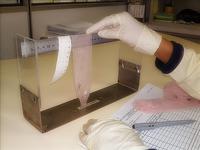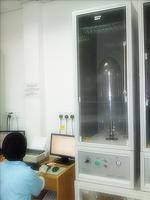- Home
- Quality condoms: a question of control and standards
QUALITY CONTROL OF MALE CONDOMS
Condoms are checked regarding the EN ISO 4074 standard which describes minimal requirements and test methods to use during quality control. We show you here some of the methods used in the plant.
Size and flexibility of condoms:
By a detailed sampling plan, we check the length, width and thickness of condoms and their stretching force.



The absence of perforations:
The physical integrity of condoms is evaluated by the absence of visible and invisible holes. For this, each condom is filled with a saline solution and is immersed in a tank containing the same saline solution. A 10V electric current is then applied: a condom that has no holes acts as an electrical insulator and does not let pass the current.
Lorem ipsum dolor sit amet, consectetur adipiscing elit. Ut elit tellus, luctus nec ullamcorper mattis, pulvinar dapibus leo.
 Another test can be done with the same condom as you roll on paper towel and where there is any leakage.
Another test can be done with the same condom as you roll on paper towel and where there is any leakage.
Burst pressure before and after aging in oven:
Condoms are tested before and after passage in an oven to cause accelerated aging. The burst pressure of the air and water volume burst are calculated to check the temperature and humidity had no significant effect on condoms.
 A condom defined as non-compliant does not observe the requirement of volume, pressure or both, or as any condom that is leaking.
A condom defined as non-compliant does not observe the requirement of volume, pressure or both, or as any condom that is leaking.
Lubricant quantity:
When the condom is smooth, we must measure the average amount of lubricant present on condoms from a batch.
Laboratory TERPAN’s condoms are all coated with 400 to 500mg of lubricant on average.
The packaging integrity :
The packaging of a condom is called a foil. It can be either square or rectangular, but rounded, in capsule, or find even more unusual shapes. Before putting a condom on the market, we must ensure that the foil is fully welded, not drilled, that condoms are not taken in the welding or even as the CE, the expiry date and number batch are shown, clearly and legibly.

